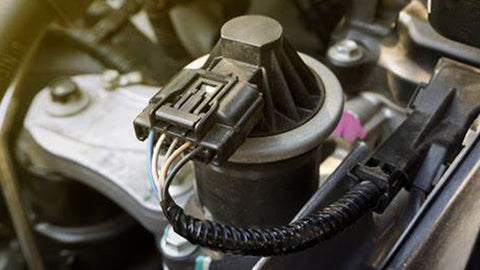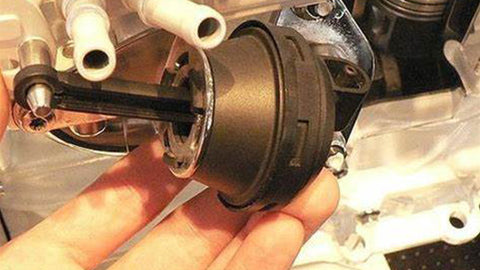What does an EGR valve do?
Author: SPELAB Mechanical Engineer (focusing on car modification for 10 years)
EGR Basics:
It is not always clear what the Exhaust Gas Recirculation (EGR) system does or why it is necessary. Nitrogen oxide (NOx) emissions from diesel and gasoline cars are regulated by law in several nations throughout the world. EGR is a practical method for reducing NOx levels. EGR functions on the theory that a controllable amount of exhaust gas is returned to the engine.One of the essential elements in lowering exhaust gas emissions and pollutants into the atmosphere is the EGR. Since the implementation of Euro 6 rules, which have reduced nitrogen oxides from Euro 5 by 55%. Nitrous Oxide (NOx) emissions from diesel engines decreased from 180 mg per mile driven to 80 mg per mile driven between Euro 5 and Euro 6 regulations.
Nitrogen oxide levels climb as exhaust gas temperatures rise (over 1800°C)! By using the EGR to circulate exhaust gas back into the input manifold, the exhaust gas temperature can be reduced by up to 300°C.
The exhaust gas recirculation system's two main components are the EGR cooler and the EGR valve. The fuel mixture's temperature will drop if some of the cooled exhaust gases are returned to the intake manifold. Nitrogen oxides are generated to a lesser extent at lower combustion temperatures. Radiators in the EGR system are used for this purpose.
The cooler's purpose is to reduce the temperature of exhaust gases returning to the input manifold. The cooler also has a bypass valve that, when activated, shuts off the cooler and forces warm gases back into the inlet manifold, helping to raise engine temperature more quickly up to 60°C before closing off.
The EGR valve regulates how much exhaust gas is returned to the intake manifold. Electronics govern the EGR system in current automobiles; the Engine Control Unit (ECU) is in charge of carefully opening the valve and uses data from numerous sensors, including the Airmass Sensor, Lambda Sensor, and Exhaust Gas Temperature Sensors (EGTS).
It is advised to replace the EGR cooler concurrently with the EGR valve when it has to be replaced. The main justification is that doing so may result in a new EGR valve's lifespan being shortened by pairing it with a contaminated cooler.
Bad EGR valve symptoms
Signs of a failing EGR valve:
- Examine engine light is on (diagnostic codes usually in the low P0400s)
- Decreased power
- Increased use of gasoline
- Pinging, tapping, or knocking sounds
- Rough idling engine
Is EGR valve repair possible?
YES, EGR valve repair is possible. In many cases, the valve only needs some minor maintenance rather than replacement. The valves accumulate a lot of carbon since exhaust gas flows past them. Since the EGR lacks both combustion and port injection of gas, it cannot wash away the carbon that a motor naturally accumulates inside of it. As a result, the valve accumulates a ton of carbon, which eventually causes it to jam and stop working. Many people have been able to remove the EGR valve from the engine and clean the carburetor by spraying it with a carb cleaner. After reinstalling the valve, they discover that it functions flawlessly once more. It might be wise to try this before investing in a new valve.
Before attempting this procedure, you should consider how challenging it was to reach the valve. In some autos, the EGR valve is fairly accessible and replacing it just takes 15 minutes. On some engines, the EGR valve is hidden by several hoses and electrical parts, making it unnecessary to attempt to clean the valve and more practical to simply replace it.
Replacing the EGR valve
If you've determined that the EGR valve requires total replacement, one thing you should be sure to accomplish concurrently is replacing the gaskets. Depending on where the valve is and how hot it might get, these gaskets are frequently either metal or paper. The EGR valve typically employs metal gaskets when it is close to the exhaust manifold and paper gaskets when it is distant from the heat. If a paper gasket is utilized, make sure to lightly oil the gasket to prevent drying out and cracking and ensure a good seal. Owners frequently encounter the issue of replacing their EGR valves only to continue to experience check engine light malfunctions. Confused by the recent EGR valve replacement, they may not realize that the real issue is leaky gaskets. When installing the gaskets, take care not to harm any of them.
EGR installation:
Before, during, and after installing a new valve and cooler, there are a few tasks you must complete.
GENERAL CHECK:
- In some systems, the engine control unit regulates the EGR valve's position. Before fitting, it is worthwhile to inspect this.
- Using a diagnostic tool, it is possible to read out the EGR settings while the engine is operating and ascertain whether it is functioning properly.
- Comparative values of the EGR control and the determined air mass also reveal information about a proper function: A smaller air mass needs to be measured if the EGR valve is opened.
VISUAL INSPECTION:
- Verify electrical wiring with connectors and/or vacuum lines.
ACTUATOR DIAGNOSIS:
- You can tell if the servomotor or electrical switching valve is operating by touching and/or hearing.
Note: Delete any EGR control-related error codes.
Many vehicles' engine control units need to be trained on the new component (basic setting/calibration) after the EGR valve has been replaced.
Note: Always adhere to the manufacturer's guidelines!
Possible problems after EGR valve replacement:
After installation, some problems could arise.:
- The new component is not working.
- The engine control unit does not recognize a new part.
Possible fault codes related to fitting a new EGR:
- P0400 – Exhaust Gas Recirculation Flow Malfunction
- P0401 – Exhaust Gas Recirculation Flow Insufficient Detected
- P0402 – Exhaust Gas Recirculation Flow Excessive Detected
- P0403 – Exhaust Gas Recirculation Circuit Malfunction
- P0404 – Exhaust Gas Recirculation Circuit Range/Performance
- P0405 – Exhaust Gas Recirculation Sensor A Circuit Low
- P0406 – Exhaust Gas Recirculation Sensor A Circuit High
- P0407 – Exhaust Gas Recirculation Sensor B Circuit Low
- P0408 – Exhaust Gas Recirculation Sensor B Circuit High
- P0409 – Exhaust Gas Recirculation Sensor "A" Circuit

If the EGR hasn't been properly coded or adapted, several codes might appear.
Because of systemic carbon pollution, valve replacements frequently do not produce the desired results. On the basis of the replacement EGR valve, for example, the system's level of contamination can be assessed (see examples – it should be an indication for a mechanic).







